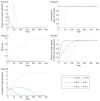The Environment and Directed Technical Change
- PMID: 26719595
- PMCID: PMC4692283
- DOI: 10.1257/aer.102.1.131
The Environment and Directed Technical Change
Abstract
This paper introduces endogenous and directed technical change in a growth model with environmental constraints. The final good is produced from "dirty" and "clean" inputs. We show that: (i) when inputs are sufficiently substitutable, sustainable growth can be achieved with temporary taxes/subsidies that redirect innovation toward clean inputs; (ii) optimal policy involves both "carbon taxes" and research subsidies, avoiding excessive use of carbon taxes; (iii) delay in intervention is costly, as it later necessitates a longer transition phase with slow growth; and (iv) use of an exhaustible resource in dirty input production helps the switch to clean innovation under laissez-faire. (JEL O33, O44, Q30, Q54, Q56, Q58).
Figures
References
-
- Acemoglu Daron. Why Do New Technologies Complement Skills? Directed Technical Change and Wage Inequality. Quarterly Journal of Economics. 1998;113(4):1055–89.
-
- Acemoglu Daron. Directed Technical Change. Review of Economic Studies. 2002;69(4):781–809.
-
- Acemoglu Daron. Equilibrium Bias of Technology. Econometrica. 2007;75(5):1371–1409.
-
- Acemoglu Daron. Introduction to Modern Economic Growth. New York: Princeton University Press; 2009.
-
- Acemoglu Daron. When Does Labor Scarcity Encourage Innovation? The Journal of Political Economy. 2010;118(6):1037–78.
Grants and funding
LinkOut - more resources
Full Text Sources

